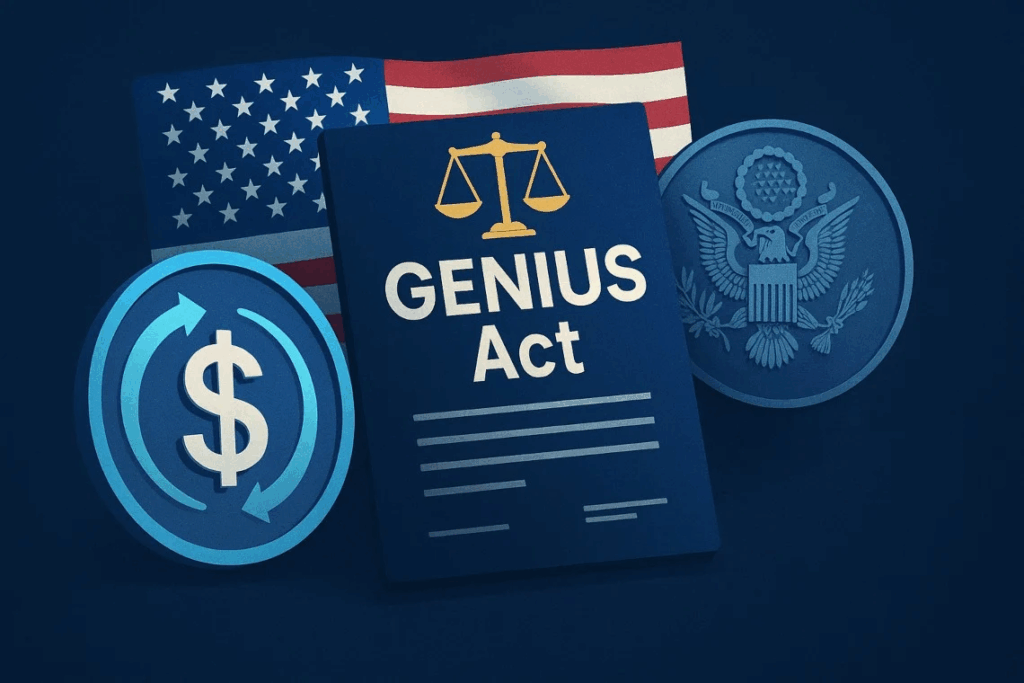- The House will vote on the GENIUS Act this week, aiming to regulate stablecoins and expand who can issue them legally.
- Supporters say it’ll strengthen trust in stablecoins, support the U.S. dollar, and boost American competitiveness in crypto.
- Critics warn of potential corruption and weak oversight, with long-term impacts likely to reach banks, fintechs, and payment networks.
So it’s officially “Crypto Week” on Capitol Hill. The House of Representatives is set to vote on a bill called the GENIUS Act, which is short for (deep breath) Guiding and Establishing National Innovation for U.S. Stablecoins. It’s one of three crypto-related bills they’re looking at this week, alongside efforts to define regulatory roles for crypto tokens and block the Fed from launching a digital dollar. Big stuff.
The GENIUS Act already passed the Senate last month with bipartisan support, and now it’s cruising toward a House vote. If it makes it through, it’ll land on President Trump’s desk to be signed into law. Speaker Mike Johnson’s backing it hard, saying it’s part of fulfilling Trump’s “digital asset agenda.” Democrats, not so much. A few of them—like Maxine Waters and Stephen Lynch—are calling this whole thing “anti-crypto corruption week” and are trying to rally against the momentum.
What Even Is a Stablecoin, and Why Does It Matter?
Stablecoins are basically crypto tokens that are pegged to the value of something stable—usually the U.S. dollar. That makes them… well, stable. Unlike Bitcoin or Ethereum that jump around in price, stablecoins are meant to stay locked at $1. That makes them super useful for payments, sending money across borders, or just parking your funds during a rough market.
In fact, more and more people in places with shaky currencies—think Latin America, Sub-Saharan Africa—are using stablecoins as a safer, digital form of cash. They’re also big in trading and DeFi, where volatility’s the name of the game. As Nic Puckrin from Coin Bureau puts it: stablecoins are already a big deal—and the use cases are only growing.
What the GENIUS Act Could Actually Change

If the GENIUS Act becomes law, it’ll basically put a rulebook in place for how stablecoins are issued and managed. Right now, the whole market is dominated by two players: Tether (USDT) and Circle (USDC). This bill would open the door for banks and companies to launch their own coins—legally and with some guardrails.
Puckrin thinks we’ll see a wave of new stablecoins enter the scene once this kicks in. Big banks are already lining up. And sure, not all of them will work—but it’ll give people options. Plus, clearer rules means more trust. That’s huge if you want more regular folks (and big companies) to start using stablecoins for real stuff, not just speculation.
Proponents also argue it’s good for the U.S. dollar. Since almost all stablecoins are pegged to USD, supporting them might actually strengthen the dollar’s position globally. Some say it’s a way to keep the U.S. competitive in the digital economy. Others just like that it brings oversight to what’s been kind of a gray zone for years.
Not Everyone’s on Board—And It Could Go Beyond Crypto
Of course, there’s pushback. Critics like Sen. Jeff Merkley warn that the bill could open the door to corruption—like politicians pushing stablecoins they’re personally invested in. Others say it spreads power too widely, letting too many entities issue coins and making oversight harder.
Interestingly, the GENIUS Act almost got tied to the Credit Card Competition Act—a stalled bill from last year that would’ve forced more payment networks beyond Visa and Mastercard. Some lawmakers thought the overlap with stablecoin payments made sense, but Senate leaders pulled it out last minute to keep the main bill alive.
Still, the long-term impact of GENIUS might spill over into retail and finance. Puckrin thinks stablecoins could become a standard option for payments, which would force banks, fintechs—and even Visa and Mastercard—to get on board or get left behind. Fees would probably drop too, which could shake things up for merchants and consumers alike. It’s not just a crypto bill—it might be a payments revolution in disguise.














